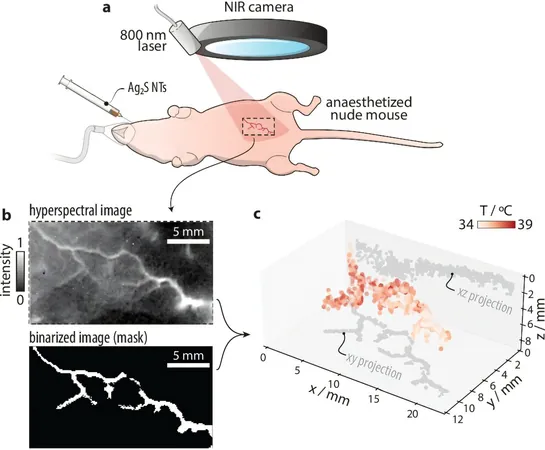
Revolutionary Breakthrough: 3D Temperature Mapping Inside Living Tissue With Light and AI!
2025-07-16
Author: Sarah
A Game-Changing Discovery for Medical Science!
In an exhilarating leap for biomedical research, a talented team from Ca' Foscari University in Venice and the Universidad Autónoma de Madrid has unveiled a revolutionary technique that maps temperature in three dimensions within living tissue. Utilizing invisible light and cutting-edge artificial intelligence, this groundbreaking method promises to redefine how we monitor body temperatures!
From Challenge to Opportunity: The Science Behind the Magic
The research, recently published in Nature Communications, aims to enhance early disease detection and treatment monitoring—all without the hefty price tag or invasiveness associated with traditional imaging technologies. Riccardo Marin, an associate professor and one of the pioneering researchers, states, "We're turning optical distortions, which are typically viewed as obstacles, into valuable sources of information. With this innovative method, we can accurately gauge both the temperature of tissues and their depth beneath the surface!"
How Does It Work? The Technology Unveiled
At the heart of this technique are luminescent nanothermometers—miniature silver sulfide (Ag₂S) particles that emit near-infrared light when activated. This glow's color and intensity fluctuate based on the particles' temperature and the biological material the light traverses. To interpret these subtle changes, the researchers developed a dual-layer neural network, trained on hundreds of hyperspectral images captured under various conditions. The result? A sophisticated model capable of generating precise, three-dimensional thermal maps, even in complex biological environments.
Proof-of-Concept: A Major Success!
In ground-breaking trials, the team successfully detected temperature variations not only in artificial tissue models but also within real biological samples. They even achieved the remarkable feat of mapping blood vessels in a live animal—marking a historic milestone in remote, high-resolution thermal imaging utilizing only light.
A Portable and Cost-Effective Solution for Diagnostics!
Unlike traditional technologies like fMRI or PET scans that necessitate costly equipment and specialized training, this new optical method is portable, safer, and significantly less expensive. This breakthrough could make diagnostics more accessible, even beyond hospital walls!
Beyond Temperature: A Future Full of Possibilities
The principles behind this technology could also be adapted to assess other crucial health parameters, such as oxygen levels and pH, simply by adjusting the optical properties of the nanoparticles.
The Unity of Collaboration and Future Endeavors
Erving Ximendes, an assistant professor and Ramón y Cajal Fellow at the Universidad Autónoma de Madrid, expresses optimism, stating, "We believe this is just the beginning. Machine learning provides us with the ability to navigate the intricate complexity of biological systems far beyond traditional methods!" This research exemplifies the power of international collaboration, showcasing Marin's fruitful tenure in Madrid and the significant contributions from students like Anna Romelli, who brought an Erasmus exchange perspective to the project.
A Bright Future: Next Steps in Cellular Research
This exciting study lays the groundwork for Marin's upcoming five-year project, MAtCHLESS, backed by a €1.5 million grant to advance luminescence nanosensing technologies. Targeting intracellular conditions such as temperature, pH, and oxygen with unparalleled precision, this initiative will explore mammalian cells and extremophile microorganisms coping with extreme conditions. The implications are huge, offering the potential for breakthroughs not just in medical diagnostics but also in biotechnology and astrobiology, possibly unlocking secrets of life in extreme environments on Earth and beyond!



 Brasil (PT)
Brasil (PT)
 Canada (EN)
Canada (EN)
 Chile (ES)
Chile (ES)
 Česko (CS)
Česko (CS)
 대한민국 (KO)
대한민국 (KO)
 España (ES)
España (ES)
 France (FR)
France (FR)
 Hong Kong (EN)
Hong Kong (EN)
 Italia (IT)
Italia (IT)
 日本 (JA)
日本 (JA)
 Magyarország (HU)
Magyarország (HU)
 Norge (NO)
Norge (NO)
 Polska (PL)
Polska (PL)
 Schweiz (DE)
Schweiz (DE)
 Singapore (EN)
Singapore (EN)
 Sverige (SV)
Sverige (SV)
 Suomi (FI)
Suomi (FI)
 Türkiye (TR)
Türkiye (TR)
 الإمارات العربية المتحدة (AR)
الإمارات العربية المتحدة (AR)